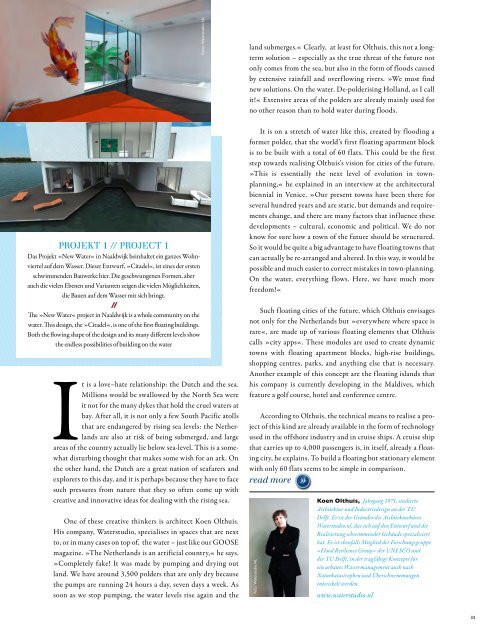Als PDF herunterladen - Robbe & Berking
Als PDF herunterladen - Robbe & Berking
Als PDF herunterladen - Robbe & Berking
Create successful ePaper yourself
Turn your PDF publications into a flip-book with our unique Google optimized e-Paper software.
projekt 1 // project 1<br />
Das Projekt »New Water« in Naaldwijk beinhaltet ein ganzes Wohnviertel<br />
auf dem Wasser. Dieser Entwurf, »Citadel«, ist eines der ersten<br />
schwimmenden Bauwerke hier. Die geschwungenen Formen, aber<br />
auch die vielen Ebenen und Varianten zeigen die vielen Möglichkeiten,<br />
die Bauen auf dem Wasser mit sich bringt.<br />
//<br />
The »New Water« project in Naaldwijk is a whole community on the<br />
water. This design, the »Citadel«, is one of the first floating buildings.<br />
Both the flowing shape of the design and its many different levels show<br />
the endless possibilities of building on the water<br />
It is a love–hate relationship: the Dutch and the sea.<br />
Millions would be swallowed by the North Sea were<br />
it not for the many dykes that hold the cruel waters at<br />
bay. After all, it is not only a few South Pacific atolls<br />
that are endangered by rising sea levels: the Netherlands<br />
are also at risk of being submerged, and large<br />
areas of the country actually lie below sea-level. This is a somewhat<br />
disturbing thought that makes some wish for an ark. On<br />
the other hand, the Dutch are a great nation of seafarers and<br />
explorers to this day, and it is perhaps because they have to face<br />
such pressures from nature that they so often come up with<br />
creative and innovative ideas for dealing with the rising sea.<br />
One of these creative thinkers is architect Koen Olthuis.<br />
His company, Waterstudio, specialises in spaces that are next<br />
to, or in many cases on top of, the water – just like our GOOSE<br />
magazine. »The Netherlands is an artificial country,« he says.<br />
»Completely fake! It was made by pumping and drying out<br />
land. We have around 3,500 polders that are only dry because<br />
the pumps are running 24 hours a day, seven days a week. As<br />
soon as we stop pumping, the water levels rise again and the<br />
Fotos: Waterstudios Nl<br />
land submerges.« Clearly, at least for Olthuis, this not a longterm<br />
solution – especially as the true threat of the future not<br />
only comes from the sea, but also in the form of floods caused<br />
by extensive rainfall and overflowing rivers. »We must find<br />
new solutions. On the water. De-polderising Holland, as I call<br />
it!« Extensive areas of the polders are already mainly used for<br />
no other reason than to hold water during floods.<br />
It is on a stretch of water like this, created by flooding a<br />
former polder, that the world’s first floating apartment block<br />
is to be built with a total of 60 flats. This could be the first<br />
step towards realising Olthuis’s vision for cities of the future.<br />
»This is essentially the next level of evolution in town-<br />
planning,« he explained in an interview at the architectural<br />
biennial in Venice. »Our present towns have been there for<br />
several hundred years and are static, but demands and requirements<br />
change, and there are many factors that influence these<br />
developments – cultural, economic and political. We do not<br />
know for sure how a town of the future should be structured.<br />
So it would be quite a big advantage to have floating towns that<br />
can actually be re-arranged and altered. In this way, it would be<br />
possible and much easier to correct mistakes in town-planning.<br />
On the water, everything flows. Here, we have much more<br />
freedom!«<br />
Such floating cities of the future, which Olthuis envisages<br />
not only for the Netherlands but »everywhere where space is<br />
rare«, are made up of various floating elements that Olthuis<br />
calls »city apps«. These modules are used to create dynamic<br />
towns with floating apartment blocks, high-rise buildings,<br />
shopping centres, parks, and anything else that is necessary.<br />
Another example of this concept are the floating islands that<br />
his company is currently developing in the Maldives, which<br />
feature a golf course, hotel and conference centre.<br />
According to Olthuis, the technical means to realise a project<br />
of this kind are already available in the form of technology<br />
used in the offshore industry and in cruise ships. A cruise ship<br />
that carries up to 4,000 passengers is, in itself, already a floating<br />
city, he explains. To build a floating but stationary element<br />
with only 60 flats seems to be simple in comparison.<br />
read more<br />
Foto: Waterstudio Nl<br />
Koen Olthuis, Jahrgang 1971, studierte<br />
Architektur und Industriedesign an der TU<br />
Delft. Er ist der Gründer des Architekturbüros<br />
Waterstudio.nl, das sich auf den Entwurf und die<br />
Realisierung schwimmender Gebäude spezialisiert<br />
hat. Er ist ebenfalls Mitglied der Forschungsgruppe<br />
»Flood Resilience Group« der UNESCO und<br />
der TU Delft, in der tragfähige Konzepte für<br />
ein urbanes Wassermanagement auch nach<br />
Naturkatastrophen und Überschwemmungen<br />
entwickelt werden.<br />
www.waterstudio.nl<br />
33


